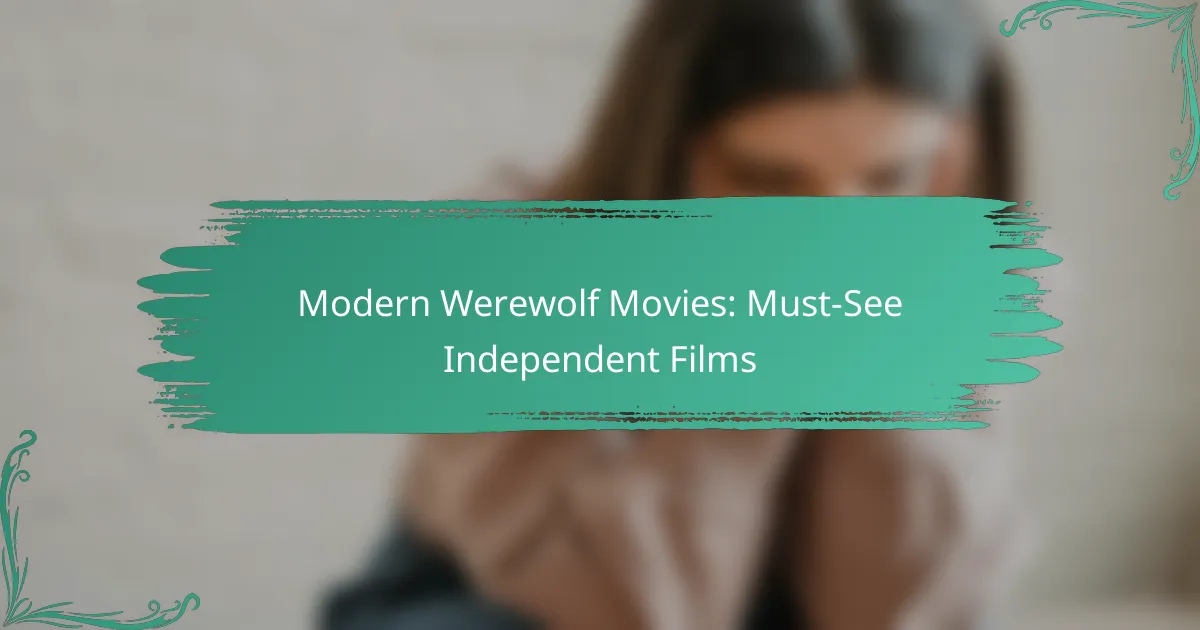Modern werewolf movies bring a refreshing twist to the classic horror genre, particularly through the lens of independent filmmaking. These films often delve into unique narratives and themes that mainstream cinema tends to overlook, offering innovative storytelling that captivates audiences seeking originality and depth in the werewolf mythos.
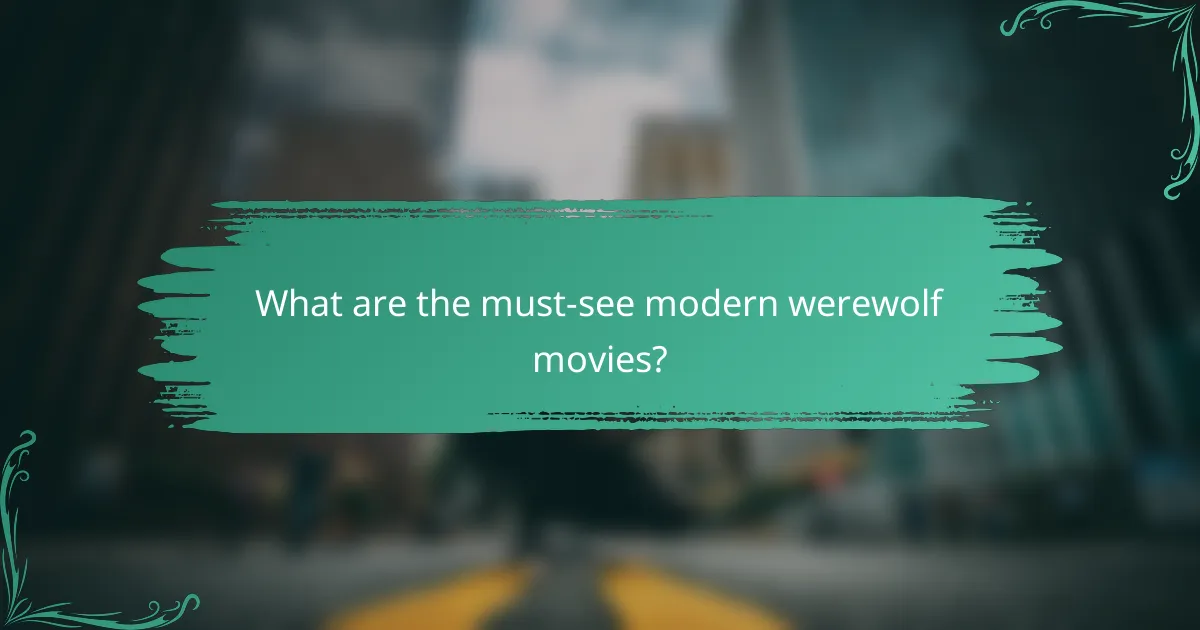
What are the must-see modern werewolf movies?
Modern werewolf movies offer a fresh take on the classic horror genre, often blending elements of drama and suspense. Independent films in this category showcase unique storytelling and innovative approaches to the werewolf mythos.
Late Phases (2014)
Late Phases follows a blind war veteran who moves to a retirement community plagued by mysterious attacks. As he investigates the deaths of his neighbors, he discovers a werewolf is responsible and must confront it to protect himself and others.
This film stands out for its character-driven narrative and exploration of themes like aging and isolation. The practical effects used for the werewolf are particularly noteworthy, enhancing the film’s tension and horror.
Howl (2015)
Howl centers on a group of train passengers who become trapped during a full moon, facing a deadly werewolf. The film combines claustrophobic settings with intense action, making it a thrilling experience for horror fans.
The character dynamics and the setting create a sense of urgency and fear, while the werewolf design pays homage to classic horror aesthetics. This film is a great choice for those who enjoy a mix of survival horror and creature feature elements.
Wolves (2014)
Wolves tells the story of a young man who discovers his werewolf heritage while trying to escape a troubled past. The film explores themes of identity and transformation, making it more than just a typical monster movie.
With a focus on character development, Wolves offers a unique perspective on the werewolf mythos. The action sequences and special effects are engaging, appealing to both horror enthusiasts and those interested in deeper narratives.
Blood and Roses (2018)
Blood and Roses is a modern retelling of the classic werewolf tale, blending romance and horror. The plot revolves around a woman who becomes entangled with a werewolf, leading to a struggle between love and survival.
This film distinguishes itself with its artistic visuals and emotional depth, exploring the complexities of love in the face of monstrous transformations. The unique approach to storytelling makes it a must-see for fans of the genre.
Ravenous (2017)
Ravenous is set in a remote Canadian community where a mysterious illness causes residents to turn into werewolves. The film combines elements of social commentary with horror, examining how fear can lead to paranoia and violence.
The cinematography captures the bleakness of the setting, enhancing the film’s atmosphere. Ravenous is notable for its thought-provoking themes and strong performances, making it a standout in modern werewolf cinema.
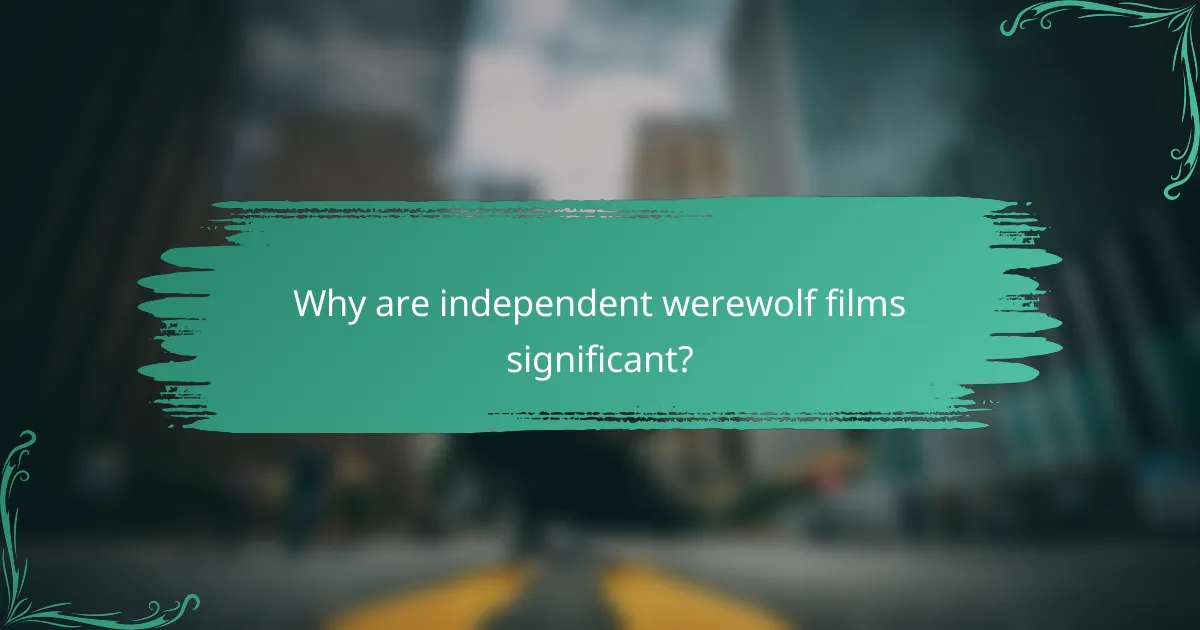
Why are independent werewolf films significant?
Independent werewolf films are significant because they often explore themes and narratives that mainstream cinema overlooks. These films provide fresh perspectives on the werewolf mythos, allowing for innovative storytelling that resonates with audiences seeking originality.
Unique storytelling perspectives
Independent werewolf films frequently delve into personal and societal issues, using the werewolf as a metaphor for transformation and identity. For instance, films like “The Wolf of Snow Hollow” blend horror with dark comedy, offering a unique take on the genre that reflects contemporary anxieties.
These films often feature diverse characters and settings, allowing for a broader exploration of cultural contexts. By focusing on character-driven narratives, independent filmmakers can highlight the emotional and psychological aspects of the werewolf legend, making it more relatable to viewers.
Creative freedom and innovation
Independent filmmakers enjoy greater creative freedom, allowing them to experiment with unconventional storytelling techniques and visual styles. This innovation can lead to unexpected twists and fresh interpretations of the werewolf archetype, as seen in films like “Ginger Snaps,” which combines horror with coming-of-age elements.
Moreover, the lower budget of independent films often encourages resourcefulness, leading to inventive practical effects and unique cinematography. This creativity not only enhances the viewing experience but also pushes the boundaries of the werewolf genre, inviting audiences to engage with the material in new ways.

How do modern werewolf movies differ from classic ones?
Modern werewolf movies often blend horror with deeper themes and character exploration, moving away from the straightforward monster narratives of classic films. They focus on psychological elements, societal issues, and personal transformation, reflecting contemporary fears and values.
Contemporary themes and settings
Contemporary werewolf films frequently incorporate themes such as identity crisis, societal alienation, and the struggle for acceptance. These films often take place in urban settings, contrasting the rural backdrops typical of classic werewolf tales. For example, a modern film might explore a character’s transformation against the backdrop of a bustling city, emphasizing feelings of isolation amidst a crowd.
Additionally, filmmakers use werewolf mythology to comment on current issues like mental health or environmental concerns. This thematic depth allows for a richer narrative that resonates with today’s audiences, making the werewolf a symbol of both personal and societal conflict.
Character development focus
In modern werewolf movies, character development is prioritized, allowing viewers to connect with the protagonists on a personal level. Unlike classic films, where the werewolf often serves as a mere monster, contemporary stories delve into the emotional and psychological struggles of the characters. This shift enables a more nuanced portrayal of the transformation process, often depicting it as a metaphor for personal growth or trauma.
Moreover, filmmakers emphasize the moral dilemmas faced by characters who grapple with their dual nature. This focus on internal conflict creates engaging narratives that challenge viewers to consider the implications of identity and humanity, making the werewolf a complex figure rather than just a horror trope.
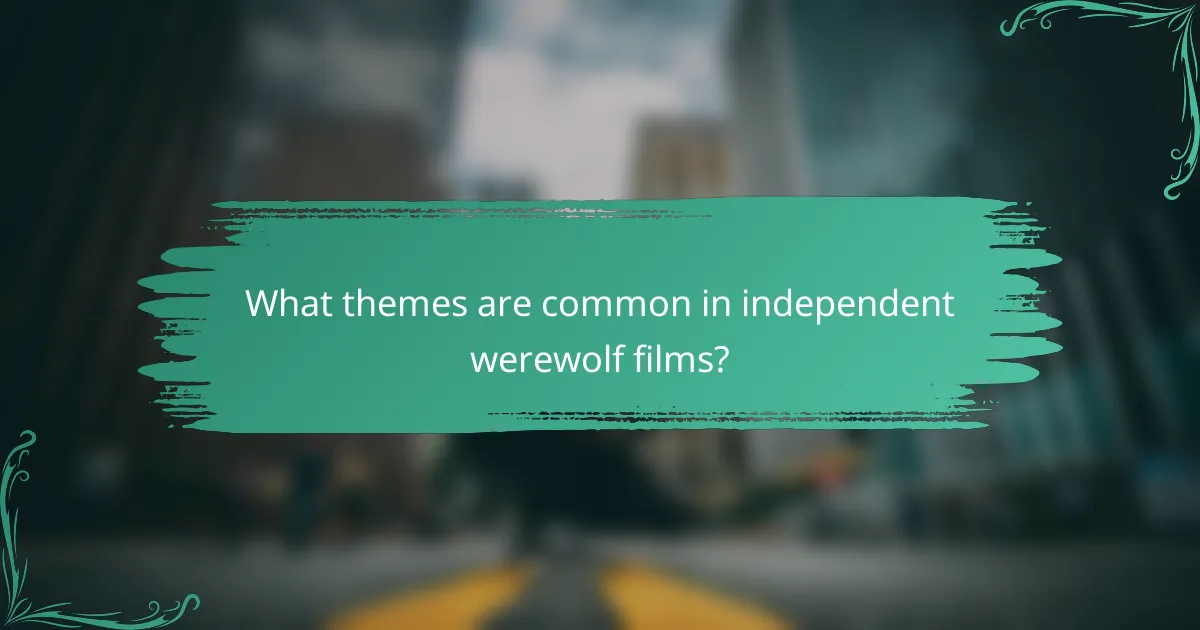
What themes are common in independent werewolf films?
Independent werewolf films often explore themes of identity, transformation, isolation, and community. These films delve into the psychological and social implications of becoming a werewolf, highlighting personal struggles and societal dynamics.
Identity and transformation
Identity and transformation are central themes in independent werewolf films, often symbolizing the struggle between one’s true self and societal expectations. Characters frequently undergo physical and emotional changes that challenge their sense of self, reflecting broader themes of adolescence, sexuality, and personal growth.
For example, a character might grapple with their newfound abilities while trying to maintain relationships, illustrating the tension between their human and beastly natures. This duality often leads to a deeper exploration of what it means to be human, as the transformation can serve as a metaphor for personal crises or societal pressures.
Isolation and community
Isolation and community play significant roles in shaping the narratives of independent werewolf films. Characters often find themselves alienated due to their transformations, leading to feelings of loneliness and despair. This isolation can be both physical and emotional, as they struggle to connect with others who may not understand their plight.
Conversely, these films also highlight the importance of community, as characters seek out others who share their experiences. This search for belonging can lead to the formation of unique bonds, emphasizing themes of acceptance and understanding in the face of adversity. The tension between isolation and the need for community often drives the plot, showcasing the complexities of human relationships in extraordinary circumstances.
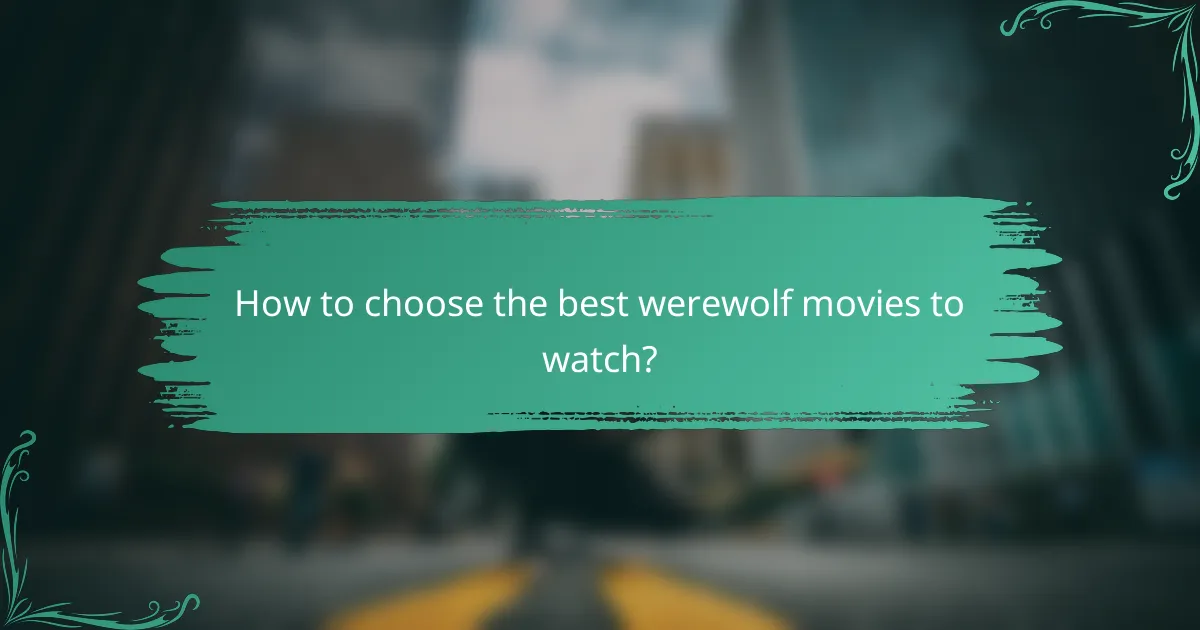
How to choose the best werewolf movies to watch?
To choose the best werewolf movies, consider the film’s genre, audience reviews, and unique storytelling elements. Independent films often offer fresh perspectives and innovative takes on traditional werewolf lore, making them worth exploring.
Consider genre blends
Many modern werewolf movies blend genres, adding depth and variety to the viewing experience. For instance, some films combine horror with comedy, while others may incorporate elements of drama or fantasy. This fusion can enhance the narrative and appeal to a broader audience.
Look for titles that mix werewolf themes with other genres, such as “The Howling” which combines horror with social commentary, or “Ginger Snaps,” which integrates coming-of-age elements. These blends can provide a richer storytelling experience.
Check audience reviews
Audience reviews are invaluable when selecting werewolf films, especially independent ones that may not have widespread marketing. Platforms like IMDb, Rotten Tomatoes, and Letterboxd can offer insights into viewers’ opinions and highlight standout features of each film.
Focus on films with a solid rating and positive feedback regarding their unique storytelling or character development. Be cautious of films with polarized reviews, as they may not align with your tastes. A quick glance at user comments can help identify whether a film is worth your time.

What are the emerging trends in werewolf cinema?
Emerging trends in werewolf cinema include a focus on psychological horror, character-driven narratives, and innovative storytelling techniques. Filmmakers are increasingly exploring themes of identity and transformation, often blending traditional werewolf lore with contemporary issues.
Character-Driven Narratives
Modern werewolf films are shifting towards character-driven narratives that delve into the emotional and psychological aspects of transformation. This approach allows audiences to connect deeply with the characters, making their struggles and fears more relatable. Films like “The Wolf of Snow Hollow” exemplify this trend by focusing on personal dilemmas alongside the horror elements.
Psychological Horror Elements
Psychological horror is becoming a staple in werewolf cinema, emphasizing the internal conflicts of characters rather than solely relying on external threats. This trend creates a more immersive experience, as viewers are drawn into the characters’ minds. Movies such as “Ginger Snaps” highlight the psychological transformation associated with becoming a werewolf, exploring themes of adolescence and identity.
Innovative Storytelling Techniques
Filmmakers are experimenting with innovative storytelling techniques, such as non-linear narratives and unique visual styles, to differentiate their werewolf films. This creativity helps to keep the genre fresh and engaging. For instance, “Howl” utilizes a claustrophobic setting and real-time storytelling to heighten tension and suspense, offering a new perspective on the werewolf mythos.
